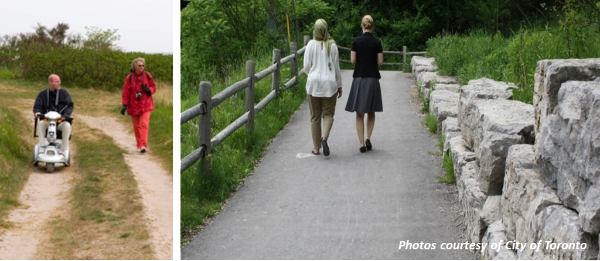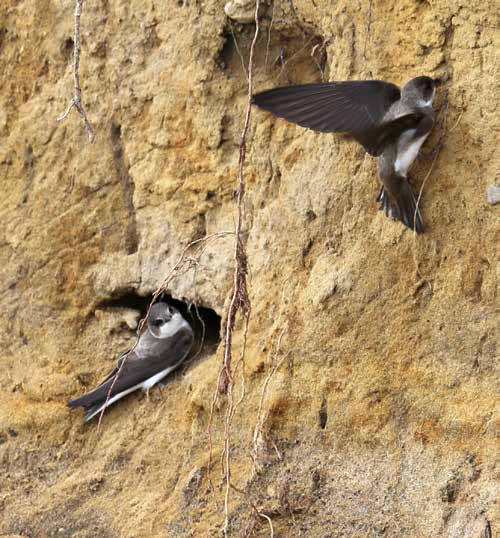Deprecated: get_currentuserinfo is deprecated since version 4.5.0! Use wp_get_current_user() instead. in /sites/dev.trca.ca/files/web/wp/wp-includes/functions.php on line 4859
Toronto’s green spaces provide residents with the opportunity to experience nature without having to travel for hours. The city contains more than 1,500 parks covering 8,000 hectares, or roughly 13% of the City’s land area, with numerous open spaces and 600 km of trails.
The Scarborough Waterfront Project aims to add to this City’s gem of greenspaces by providing safe access along the Scarborough waterfront. Specifically, the project aims to create an 11 km trail system from Bluffer’s Park to East Point Park.
One of the major considerations of the Project is to create a connected trail system along the waterfront that is accessible and inclusive; a trail that can be safely used and enjoyed by all, no matter of their age or physical ability. As stated in a City of Toronto Accessibility Plan report: “Toronto is one of the most diverse cities in the world and it has a long-standing goal of becoming an inclusive society where all residents, many of whom are people with disabilities, are able to fully participate in the social, cultural, recreational, economic and political life of the City.” The Scarborough Waterfront Project seeks to further this goal.

The Accessibility for Ontarians with Disabilities Act (AODA) formalizes the legal requirement to incorporate accessibility into trail design in Ontario. The Act was enacted by the provincial government in 2005 to help make Ontario accessible to people with disabilities and lays the framework for the development of province-wide mandatory standards for accessibility in all areas of daily life.
The Scarborough Waterfront Project will consider AODA wherever possible; however, given the nature of the terrain of the Bluffs, it may not be achievable in every section (i.e. Slope of the Doris McCarthy Tail). Consultation will be undertaken so that the trail system meets the requirements of the AODA and City of Toronto trail guidelines to the greatest extent possible.
Overall, planning with everyone in mind is a holistic approach that the City of Toronto and TRCA are committed to applying. Residents and visitors regularly use Toronto’s trail system and creating a trail that allows everyone equal opportunity to access the waterfront with independence and dignity is an important factor of the Scarborough Waterfront Project.
Bank Swallows
Many areas along the Scarborough Bluffs have conditions that allow bank swallows to nest and surveys have documented hundreds of burrows within the Project Study Area.
Bank swallows require vertical or near-vertical banks without vegetation to nest in. These swallows dig out burrows in the bank and build a nest at the end of the burrow, so soils need to be soft enough for digging, but sturdy enough not to collapse. They are a “threatened” Species at Risk and are protected under the Endangered Species Act.
Each Alternative considered in the Scarborough Waterfront Project includes an evaluation on how the Alternative may impact Species at Risk. TRCA is working with the Ministry of Natural Resources and Forestry as part of the evaluation and identification of a Preferred Alternative.

Bank swallows are also “aerial insectivores”, meaning they fly through the air foraging on flying insects.
The Scarborough Waterfront Project is also looking at ways that improve foraging for bank swallows and other aerial insectivores such as improving substrates in the nearshore area of Lake Ontario which will help boost insect productivity.
During recent breeding bird survey work, TRCA captured footage of thriving bank swallow colonies residing along the west end of the Scarborough shoreline. Notice the heads of chicks in some of the burrows. There are three in the middle of the screen that are close to fledging and they are near the burrow entrance begging for food. Both parents bring food to the nestlings.
Project Update
Thank you to everyone who provided comments following the 2nd public meeting held on June 28th!
Here are the next steps the Project Team will be taking now that the comment period has closed:
- The Preliminary Overall Preferred Alternative will be refined based on public and agency input.
- A detailed assessment of the revised Overall Preferred Alternative will be undertaken as the Detailed Effects Assessment.
- The refined Overall Preferred Alternative and Detailed Effects Assessment will be presented to the public for feedback in the fall.
